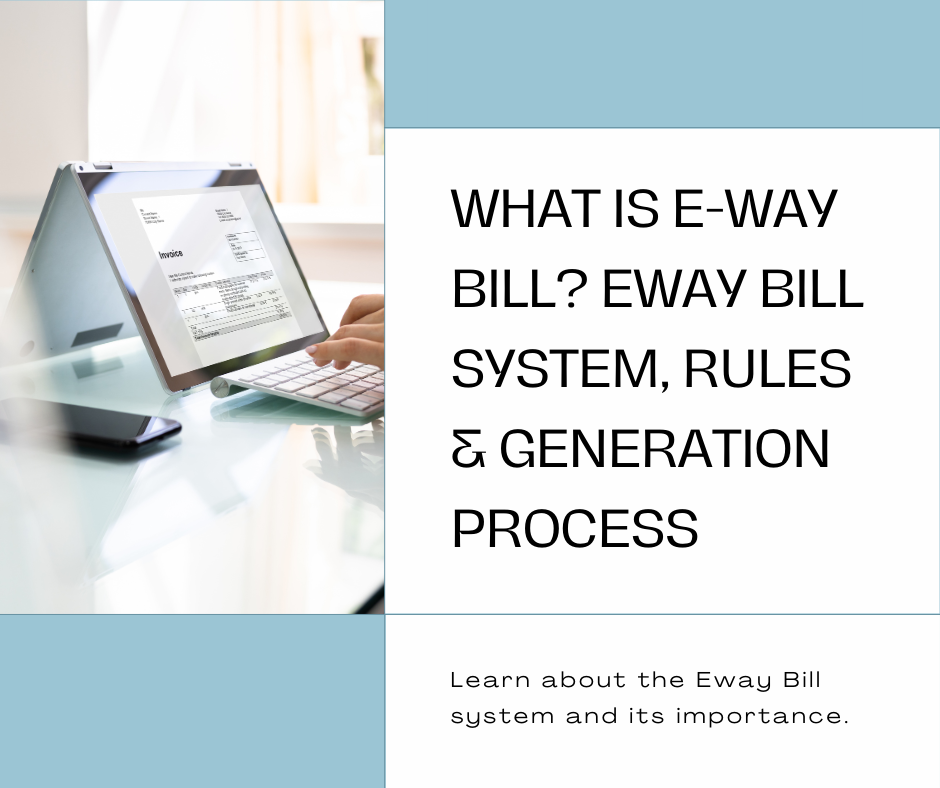What is E-way Bill? Eway Bill System, Rules And Generation Process




The E-way Bill system is a crucial aspect of the Goods and Services Tax (GST) regime. E-billing offers a modern approach to invoicing and payment, replacing paper bills with a convenient electronic system. Customers can access their e-bills through a company website or receive them via email with an attached electronic document. This allows for easy online review of bills before making a payment.
What is the E-way Bill?
An e-way bill is an electronic permit functioning as a permit for transporting goods. The Goods and Services Tax (GST) regime introduced a revolutionary system for streamlining the movement of goods: the E-way Bill system. It acts as a virtual record containing crucial details about the consignment, including:
- Description of goods
- Value of goods
- Origin and destination of the goods
- Details of the supplier (consignor) and recipient (consignee)
- Transporter information (if applicable)
The e-way bill system promotes transparency and efficiency in goods movement by:
- Facilitating Tax Compliance: It ensures businesses adhere to GST regulations and pay the applicable taxes.
- Curbing Tax Evasion: By tracking goods movement, it deters practices like transporting unregistered goods.
- Reducing Checkpoints: E-way bills minimize the need for physical verification at checkpoints, leading to smoother movement.
The advantages of e-billing extend beyond just streamlining the invoicing and payment process. E-billing reporting provides valuable financial insights that can be used for forecasting and making informed decisions about cash flow. For example, a company might consider invoice financing or factoring based on this data. There are two primary methods for e-billing payments: biller-direct and bank aggregator. Biller-direct systems have customers login to the company's website to view and pay their bills, while bank aggregator systems have customers access their e-bills and make payments through their bank's online interface.
Read Also | How AI is Revolutionizing Your Accounts Payable?
Who Needs an E-way Bill?
The responsibility of generating an e-way bill typically falls on one of the following parties:
- Registered Supplier: If the consignment value exceeds ₹50,000, a registered supplier under GST must generate the e-way bill.
- Registered Recipient: In specific cases, the registered recipient can generate the e-way bill if the supplier is unregistered.
- Transporter: The transporter can also generate the e-way bill, especially if pre-informed about the movement of goods exceeding the threshold value.
Important Note: All parties involved (supplier, recipient, transporter) have the right to access the e-way bill details after generation.
When is an E-way Bill Required?
An E-way bill is mandatory for the movement of goods exceeding ₹50,000 in value, applicable to both inter-state (between states) and intra-state (within a state) transportation. However, there are exceptions:
- Goods Upto ₹50,000: Movement of goods with a total value of ₹50,000 or less is exempt.
- Specific Goods: Exempted goods under GST or perishable items may be exempt under specific provisions.
- Movement Within a State: Some states may have a higher threshold value for intra-state movement before requiring an e-way bill. Check with your state's GST authorities for variations.
Pro Tip: Always stay updated on the latest E-way bill rules and threshold limits applicable to your state to ensure compliance.
See Also | 5 Steps to Follow For Implementing E-invoicing
Pre-Requisites for Generating an E-Waybill
To generate an e-way bill, you will need the following:
- GSTIN of Supplier and Recipient: A valid GST Identification Number (GSTIN) of both the supplier and recipient is mandatory.
- Product Description: A clear description of the goods being transported is required.
- HSN Code: The Harmonized System Nomenclature (HSN) code for the specific goods must be included.
- Invoice/Bill Details: Information from the invoice or bill related to the consignment, such as value and quantity, needs to be provided.
- Transporter Details (if applicable): If a transporter is involved, their details like vehicle registration number need to be entered.
Generating an E-way Bill: A Step-by-Step Guide
The E-way Bill system is a user-friendly online portal accessible at E-Way Bill.
Here's a breakdown of the process:
- Registration: Businesses registered under GST can access the portal using their GST login credentials.
- E-way Bill Generation: Enter details like supplier information, recipient information, product description with HSN/SAC code, and vehicle details (if applicable).
- Document Upload (Optional): Upload supporting documents like invoices or purchase orders for reference (not mandatory).
- E-way Bill Confirmation: Upon successful submission, a unique E-way Bill Number (EBN) is generated, serving as electronic permission for transporting the goods.
Remember: Ensure the e-way bill remains valid throughout the transportation journey to avoid penalties.
Required Documents for E-way Bill Generation
The documents required for generating an e-way bill depend on the mode of transportation:
Common Documents:
- Invoice/Bill of Supply/Challan: A copy of the invoice or document related to the consignment is mandatory.
Example:
If an e-way bill is generated for a consignment traveling 520 kms by a regular conveyance, the validity would be:
- Initial validity (less than 200 kms): 1 Day
- Additional validity (for 320 kms - additional 200 kms): 2 Days (1 Day for every additional 200 kms or part thereof)
- Total Validity: 1 Day + 2 Days = 3 Days
Additional Documents Based on Transportation Mode:
- Transport by Road: Transporter's ID or vehicle registration number.
- Transport by Rail, Air, or Ship: Transporter's ID, transport document number, and date on the document.
Validity of E-way Bills
The validity period of an e-way bill depends on the distance traveled by the goods. It typically follows a one-day validity for every 100 kilometers.
Must Know | Top 5 AI Billing Software for Small Businesses in 2024
Conclusion
Understanding the E-way Bill system empowers businesses to navigate the movement of goods seamlessly while adhering to GST regulations. By following these guidelines and staying updated on any revisions, businesses can ensure a smooth flow of goods.